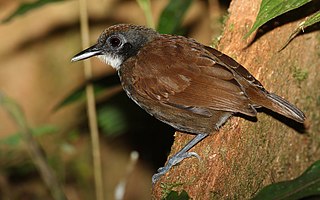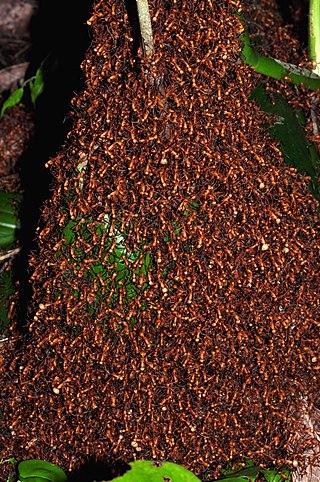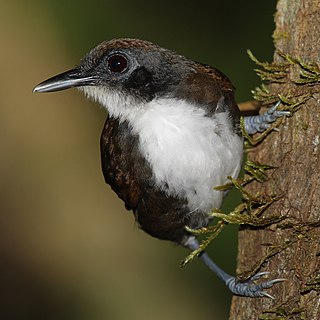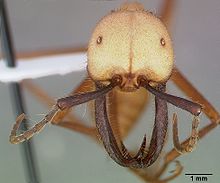
Ants are eusocial insects of the family Formicidae and, along with the related wasps and bees, belong to the order Hymenoptera. Ants evolved from vespoid wasp ancestors in the Cretaceous period. More than 13,800 of an estimated total of 22,000 species have been classified. They are easily identified by their geniculate (elbowed) antennae and the distinctive node-like structure that forms their slender waists.

The antbirds are a large passerine bird family, Thamnophilidae, found across subtropical and tropical Central and South America, from Mexico to Argentina. There are more than 230 species, known variously as antshrikes, antwrens, antvireos, fire-eyes, bare-eyes and bushbirds. They are related to the antthrushes and antpittas, the tapaculos, the gnateaters and the ovenbirds. Despite some species' common names, this family is not closely related to the wrens, vireos or shrikes.

The pharaoh ant is a small (2 mm) yellow or light brown, almost transparent ant notorious for being a major indoor nuisance pest, especially in hospitals. A cryptogenic species, it has now been introduced to virtually every area of the world, including Europe, the Americas, Australasia and Southeast Asia. It is a major pest in the United States, Australia, and Europe.

A bivouac is an organic structure formed by migratory driver ant and army ant colonies, such as the species Eciton burchellii. A nest is constructed out of the living ant workers' own bodies to protect the queen and larvae, and is later deconstructed as the ants move on.

The name army ant (or legionary ant or marabunta) is applied to over 200 ant species in different lineages. Because of their aggressive predatory foraging groups, known as "raids", a huge number of ants forage simultaneously over a limited area.

Eciton is a New World army ant genus that contains the most familiar species of army ants. The most predominant and well-known species is Eciton burchellii, which is also more commonly known as the army ant and is considered the type species.

Formica polyctena is a species of European red wood ant in the genus Formica and large family Formicidae. The species was first described by Arnold Förster in 1850. The latin species name polyctena is from Greek and literally means 'many cattle', referring to the species' habit of farming aphids for honeydew food. It is found in many European countries. It is a eusocial species, that has a distinct caste system of sterile workers and a very small reproductive caste. The ants have a genetic based cue that allow them to identify which other ants are members of their nest and which are foreign individuals. When facing these types of foreign invaders the F. polyctena has a system to activate an alarm. It can release pheromones which can trigger an alarm response in other nearby ants.
Task allocation and partitioning is the way that tasks are chosen, assigned, subdivided, and coordinated within a colony of social insects. Task allocation and partitioning gives rise to the division of labor often observed in social insect colonies, whereby individuals specialize on different tasks within the colony. Communication is closely related to the ability to allocate tasks among individuals within a group. This entry focuses exclusively on social insects. For information on human task allocation and partitioning, see division of labour, task analysis, and workflow.

Ant followers are birds that feed by following swarms of army ants and take prey flushed by those ants. The best-known ant-followers are 18 species of antbird in the family Thamnophilidae, but other families of birds may follow ants, including thrushes, chats, ant-tanagers, cuckoos, motmots, and woodcreepers.

Eusociality, is the highest level of organization of sociality. It is defined by the following characteristics: cooperative brood care, overlapping generations within a colony of adults, and a division of labor into reproductive and non-reproductive groups. The division of labor creates specialized behavioral groups within an animal society which are sometimes referred to as 'castes'. Eusociality is distinguished from all other social systems because individuals of at least one caste usually lose the ability to perform behaviors characteristic of individuals in another caste. Eusocial colonies can be viewed as superorganisms.

Carebara diversa, the East Indian harvesting ant, is a species of marauder ant widely distributed throughout Asia.

The green-head ant is a species of ant that is endemic to Australia. It was described by British entomologist Frederick Smith in 1858 as a member of the genus Rhytidoponera in the subfamily Ectatomminae. These ants measure between 5 and 7 mm. The queens and workers look similar, differing only in size, with the males being the smallest. They are well known for their distinctive metallic appearance, which varies from green to purple or even reddish-violet. Among the most widespread of all insects in Australia, green-head ants are found in almost every Australian state, but are absent in Tasmania. They have also been introduced in New Zealand, where several populations have been established.

Dorylus laevigatus is a member of the army ant genus Dorylus, or Old World army ants. More specifically known as "driver ants", the genus Dorylus is abundant throughout Africa and stretches into tropical Asia, where D. laevigatus is primarily found. They are a eusocial colony-forming species, which live primarily underground, rarely venturing to the surface for any reason. D. laevigatus colonies are small for army ants, estimated averages falling between 30,000 and 1,000,000 individuals.

Macrotermes bellicosus is a species of Macrotermes. The queens are the largest amongst known termites

Formica truncorum is a species of wood ant from the genus Formica. It is distributed across a variety of locations worldwide, including central Europe and Japan. Workers can range from 3.5 to 9.0mm and are uniquely characterized by small hairs covering their entire bodies. Like all other ants, F. truncorum is eusocial and demonstrates many cooperative behaviors that are unique to its order. Colonies are either monogynous, with one queen, or polygynous, with many queens, and these two types of colonies differ in many characteristics.

An ergatoid is a permanently wingless reproductive adult ant or termite. The similar but somewhat ambiguous term ergatogyne refers to any intermediate form between workers and standard gynes. Ergatoid queens are distinct from other ergatogyne individuals in that they are morphologically consistent within a species and are always capable of mating, whereas inter caste individuals, another class of ergatogynes, often are not. Ergatoids can exhibit wide morphological differences between species, sometimes appearing almost identical to normal workers and other times being quite distinct from both workers and standard queens. In addition to morphological features, ergatoids among different species can exhibit a wide range of behaviors, with some ergatoids acting only as reproductives and others actively foraging. Ergatoid queens have developed among a large number of ant species, and their presence within colonies can often provide clues on the social structures of colonies and as to how new colonies are founded. Without wings, almost all species of ants that solely produce ergatoid queens establish new colonies by fission.

The Central American paper wasp is a nocturnal eusocial wasp. It is famous for its swarm based emigration behavior, and is native to the lowlands of Central and northern South America. This species has developed special night vision adaptations to facilitate their night-time swarming and foraging behavior and has important medicinal properties for the Pankararú people of Brazil.

Polybia sericea is a social, tropical wasp of the family Vespidae that can be found in South America. It founds its colonies by swarming migrations, and feeds on nectar and arthropods.

Megaponera analis is the sole species of the genus Megaponera. They are a strictly termite-eating (termitophagous) ponerine ant species widely distributed in Sub-Saharan Africa and most commonly known for their column-like raiding formation when attacking termite feeding sites. Their sophisticated raiding behaviour gave them the common name Matabele ant after the Matabele tribe, fierce warriors who overwhelmed various other tribes during the 1800s. With some individuals reaching up to 25 millimetres (0.98 in) in length, M. analis is one of the world's largest ants.
This is a glossary of terms used in the descriptions of ants.
























